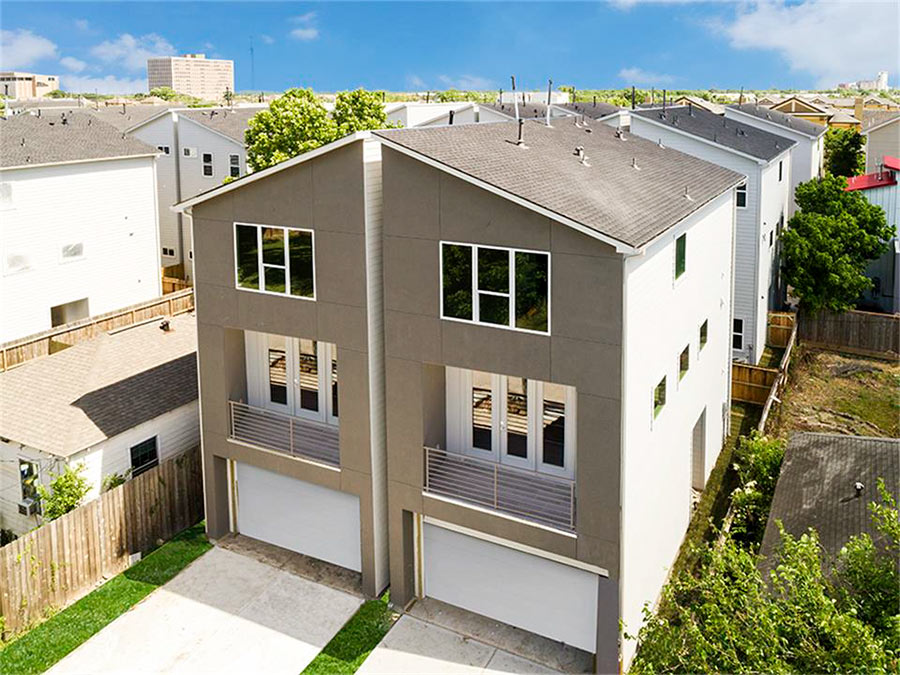COMMENT OF THE DAY: THE BIG THINGS YOU GET WHEN YOU LEAVE JUST A TINY SPACE BETWEEN HOUSES  “The City of Houston’s codes are different for a ‘free-standing’ or ‘detached’ ‘single-family’ home, as opposed to a two- or multi-family property of some sort. Detention, lot coverage, building code, legal description, all different. So maintaining even the tiniest gap means you have a fee-simple, stand-alone property.” [dave102, commenting on Can You Beat This Townhome Gap?] Photo of 3108 Baer St., Fifth Ward: HAR
“The City of Houston’s codes are different for a ‘free-standing’ or ‘detached’ ‘single-family’ home, as opposed to a two- or multi-family property of some sort. Detention, lot coverage, building code, legal description, all different. So maintaining even the tiniest gap means you have a fee-simple, stand-alone property.” [dave102, commenting on Can You Beat This Townhome Gap?] Photo of 3108 Baer St., Fifth Ward: HAR





so what are the specific “code” advantages for a single family vs. attached?
I don’t think there are any. Builders do it because buyers don’t like to share walls. It’s cheaper to build them together and you can fit more on less space, which is why they almost all used to be attached.
Insurance is better for a single family home but i think there is a distance requirement of 3ft…. but im not an expert.
@diggity – The difference would be in the requirements for either multifamily or single family. It’s at the end of the day and i’m tired – you will need to look that up and compare. I believe the shared wall “Townhome” will need to have an HOA recorded for the maintenance of shared elements which would involve some headache for the builders and the potential homeowners.
FYI:
Each of these town-homes reside on their own respective lot; so regardless of whether or not they are attached, they are still considered “single-family” by the ordinance. A lot, by definition (e.g. Ch. 42) is A.) one home, B.) one home +a garage apartment; or C.) one duplex.
It only becomes multifamily when A.) it’s platted as a reserve; and, B.) there are three or more units.
Attached homes have to be listed as “townhomes” on HAR. Detached can be listed as single family. That is one factor that drives the pricing, and therefore the naming.
@diggity – The difference would be in the requirements for either multifamily or single family. It’s at the end of the day and i’m tired – you will need to look that up and compare. I believe the shared wall “Townhome†will need to have an HOA recorded for the maintenance of shared elements which would involve some headache for the builders and the potential homeowners.
____________
As was mentioned, the multi-family/single family thing has nothing to do with permitting. Even if you’re separated by a few inches, the fire wall codes are still in play. They may or may not need to form a PUD but it’s boilerplate paperwork and oftentimes you’ll still need this even if the homes are detached.
It’s for marketing, plain and simple. If buyers would pay the same for attached homes, builders would still make them attached.
This is Houston. Plants grow everywhere… One of these homes will soon have something (ultimately a tree) growing between them that cannot be removed. Then what? The code that allows this is insane. As is the buyer of one of these homes.
Two big factors:
1. Marketing “Single family home inside the Loop” sounds better than “Duplex inside the Loop” or “Condo inside the Loop” even if the yard is 5ft x 10 ft and your neighbors are only an arms length away.
2. Higher sales price = higher tax revenue. It is in the best interest of the CoH to allow a pack of 3 or 4 “single family houses” onto a subdivided lot (and sell for $400k each for a total value of $1.2 to $1.6M)) than have a solo single family house on the same lot that sells for $800 or $900k.
Call it whatever euphemism you like: densification; walkability; gentrification; urban renewal; revitalization, …
For developers and the CoH the bottom line is the bottom line; just follow the money….
Keep the shady in Shady Acres ya’ll.
@Greg-in-WHeights:
RoundUp for Woody Vines will take care of any tree growing up in the big crack between these homes. Of course don’t try to have a nice garden nearby. I categorically do not recommend this (and think these sorts of broad killing products should be banned), but, that’s how it’s done.
@movocelot: Glyphosate, the active ingredient in Roundup does not translocate in the soil. Airborne spray residue can, however, harm other plants in the area.
If you’re trying to kill the weeds in a 6-12″ crack between two 80′-long, 40′-tall modern day shotgun shacks, how exactly are you supposed to get the Roundup down in there?
Google master, you soak a rope with it and floss.
J, thank you for that visual! I giggled.